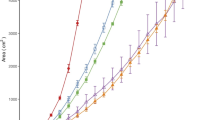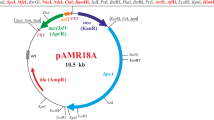Summary
Five β-lactam producing fungi were selected to elaborate techniques for parasexual recombination with respect to a transgression of the species and genus limits.
-
1.
These fungi, obtained from strain collections, were reclassified according to the morphological properties and in using biochemical methods as: Emericellopsis glabra, Emericellopsis salmosynnemata, Cephalosporium acremonium, Cephalosporium spec., and Paecilomyces carneus.
-
2.
Techniques were developped to produce variants as genetic markers and heterokaryons via protoplast fusion.
-
3.
It was possible to obtain parasexual recombinants of the marker genes not only in intraspecific but also in interspecific and intergeneric crosses. However, the number of recombinants decreased from 10−4 via 5 · 10−5 to 10−5 with increasing taxonomic diversity.
-
4.
Mophological characters, such as conidiation and to a certain extent also the ability to produce antibiotics, may be transferred via protoplast fusion and subsequent parasexual recombination. It becomes obvious that this technique may be used for strain improvement in Biotechnology.
Similar content being viewed by others
References
Anne J, Peberdy JF (1975) Conditions for induced fusion of fungal protoplasts in polyethylene glycol solutions. Arch Microbiol 105:201–205
Benscon BW, Grosklags JH (1969) Nuclei of the genus Emericellopsis. Mycologia 61:718–725
Caten CE (1981) Parasexual processes in fungi. In: Gull K, Oliver SG (eds) The fungal nucleus. Cambridge University Press, pp 191–212
Elander RP, Stauffer JF, Backus MP (1960) Antibiotic production by species and varieties of Cephalosporium and Emericellopsis. In: Gray P (ed) Antimicrobial Agents. Annual Plenum Press, New York, pp 91–102
Esser K (1976) Genetic factors to be considered in maintaining living plant collections. In: Simmons JB, Beyer RI, Brandham PE, Lucas GLI, Parry VTH (eds) Conservation of threatened plants. Plenum Press, London, pp 185–198
Fantini AA (1962) Genetics and antibiotic production of Emericellopsis species. Genetics 47:161–177
Ferenczy L, Kevei F, Szegedi M, Franko A, Rojik I (1976) Factors affecting high frequency fungal protoplast fusion. Experientia 32:1156–1158
Gams W (1971) Cephalosporium-artige Schimmelpilze (Hyphomycetes). Fischer, Stuttgart
Hamlyn PF, Ball C (1979) Recombination studies with Cephalosporium acremonium. In: Genetics of Industrial Microorganisms. American Society for Microbiology, Washington pp 185–191
Hoffmann P, Esser K (1978) Genetics of speciation in the basidiomycetous genus Polyporus. Theor Appl Genet 53:273–282
Holliday R (1956) A new method for the identification of biochemical mutants of micro-organisms. Nature 178:987
Käfer E (1977) Meiotic and mitotic recombination in Aspergillus and its chromosomal aberrations. Adv Genet 19:33–131
Kanzaki T, Fujisawa Y (1976) Biosynthesis of cephalosporins. Adv Microbiol 20:159–201
Kitano K, Kintaka K, Suzuki S, Katamoto K, Nara K, Nakao Y (1975) Screening of microorganisms capable of producing β-lactam antibiotics. J Ferment Technol 53:327–338
Lhoas P (1961) Mitotic haploidization by treatment of Aspergillus niger diploids with p-fluoropenylalanine. Nature 190:734
Minuth W, Tudzynski P, Esser K (1982) Extrachromosomal genetics of Cephalosporium acremonium. I. Characterization and mapping of mitochondrial DNA. Curr Genet 5:227–231
Nash CH, Huber FM (1971) Antibiotic synthesis and morphological differentiation of Cephalosporium acremonium. Appl Microbiol 22:6–10
Nüesch J, Treichler HJ, Liersch M (1973) The biosynthesis of cephalosporin C. In: Vanek Z, Hostalek Z, Cudlin J (eds) Genetics of industrial microorganisms: actinomycetes and fungi. Academia, Prague, pp 309–334
Puhalla JE, Mayfield JE (1974) The mechanism of heterokaryotic growth in Verticillium dahliae. Genetics 76:411–422
Roberts CF (1959) A replica plating technique for the isolation of nutritionally exacting mutants of a filamentous fungus (Aspergillus nidulans). J Gen Microbiol 20:540–548
Robinow CF, Caten CE (1969) Mitosis in Aspergillus nidulans. J Cell Sci 5:403–431
Saunders G, Allsop AA, Holt G (1982) Modern developments in mutagenesis. J Chem Tech Biotechnol 32:354–364
Schildkraut CL, Marmur J, Doty F (1962) Determination of the base composition of DNA from its density in caesium chloride. J Mol Biol 4:440–443
Singh M, Sinha U (1976) Chloral hydrate induced haploidization in Aspergillus nidulans. Experientia 32:1144–1145
Stahl U (1978) Zygote formation and recombination between like mating types of the yeast Saccharomycopsis lipolytica by protoplast fusion. Mol Gen Genet 160:111–113
Stauffer JF, Schwartz LJ, Brady CW (1966) Problems and progression in a strain selection program with cephalosporin-producing fungi. Dev Ind Microbiol 7:104–113
Szybalski W (1952) Microbial selection. I. Gradient plate technique for study of bacterial resistance. Science 116:46
Szybalski W (1968) Use of caesium sulfate for equilibrium density centrifugation. In: Colowick SP, Kaplan NO (eds) Methods in Enzymology Vol. XII B. Academic Press, New York, pp 330–360
Traxler P, Treichler HJ, Nüesch J (1975) Synthesis of N-acetyldeacetoxycephalosporin C by a mutant of Cephalosporium acremonium. J Antibiot 28:605–606
Tuveson RW, Coy DO (1963) Hyphal-tip isolations as a criterion for heterocaryosis in Cephalosporium mycophilium. Mycologia 55:402–414
Upshall A, Giddings B, Mortimore ID (1977) The use of benlate for distinguishing between haploid and diploid strains of Aspergillus nidulans and Aspergillus terreus. J Gen Microbiol 100:413–418
Wallhäußer KH, Schmidt H (1967) Sterilisation, Desinfektion, Konservierung, Chemotherapie. Thieme, Stuttgart, S. 412–420
Author information
Authors and Affiliations
Rights and permissions
About this article
Cite this article
Minuth, W., Esser, K. Intraspecific, interspecific, and intergeneric recombination in β-lactam producing fungi via protoplast fusion. European J. Appl. Microbiol. Biotechnol. 18, 38–46 (1983). https://doi.org/10.1007/BF00508127
Received:
Issue Date:
DOI: https://doi.org/10.1007/BF00508127




